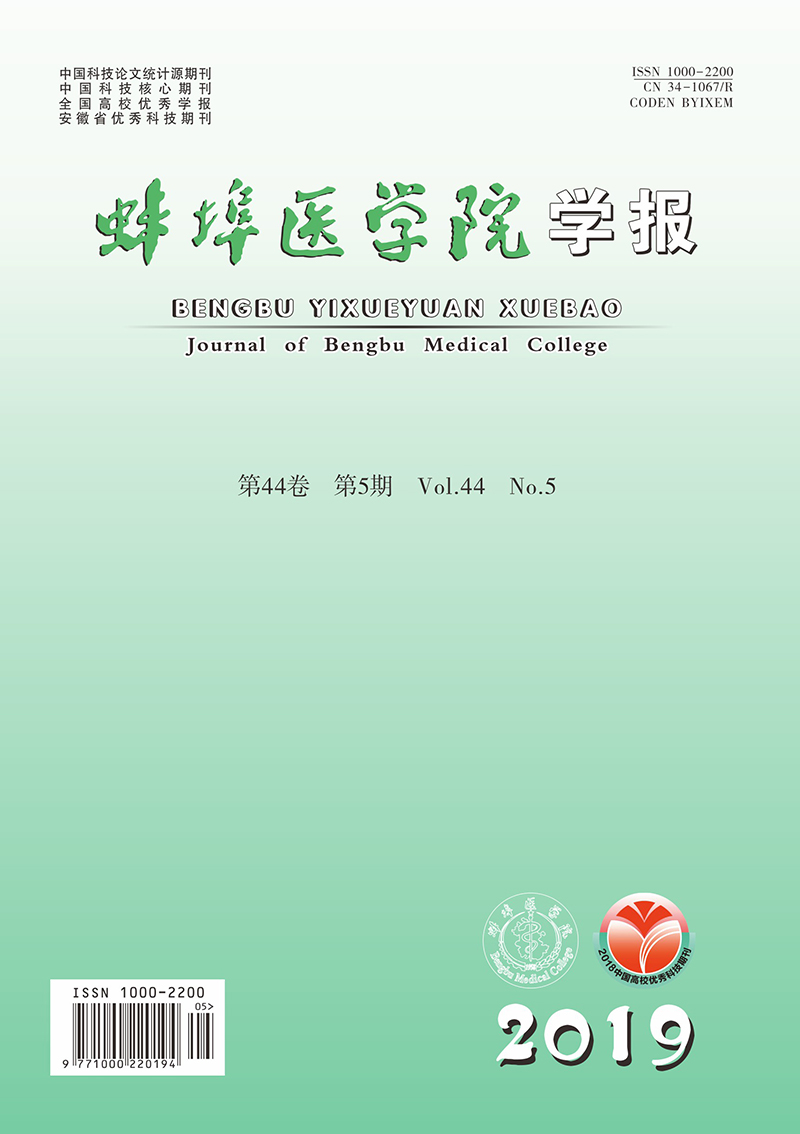-
腔隙性脑梗死(lacunar stroke,LS)是颅穿支动脉供血区缺血后导致脑干或大脑半球深部梗死[1]。LS的致病因素主要包括纤溶系统、凝血系统与血小板功能等[2]。血栓弹力图(thrombelastography,TEG)是通过动态监测纤溶系统、凝血系统与血小板聚集等过程以有效评价凝血功能,有助于动态反映纤溶状况、血小板功能、纤维蛋白原水平与凝血因子水平等,是整体评估凝血功能的检测手段之一[3]。TEG通过准确检测最大振幅、凝固角、凝固时间与反应时间等参数以准确评定凝血功能,在及时发现与诊断脑血栓合并高凝状态中具有重要的指导意义。但目前关于TEG对LS发展为进展性脑梗死(progressive lacunar stroke,PLS)的预测意义研究较为罕见。本文就TEG在预测LS发展为PLS中的作用作一报道。
HTML
-
选取2017年我科收治的LS病人142例,男98例,女44例,年龄49~68岁。随访3个月,根据是否发展为PLS将病人分为PLS组(46例)与无PLS组(Non-PLS组,96例)。2组性别、年龄、入院时美国国立卫生院神经功能缺损评分(NHISS)、糖尿病、高血压、吸烟史、血清肌酐、高密度脂蛋白胆固醇(HDL-C)、低密度脂蛋白胆固醇(LDL-C)、三酰甘油(TG)、总胆固醇(TC)、氯吡格雷、阿司匹林、受教育程度、婚姻状况及医疗付费方式等方面差异均无统计学意义(P>0.05)(见表 1),具有可比性。本研究经本院医学伦理委员会批准。
分组 男 女 年龄/岁 入院时NHISS评分/分 糖尿病 高血压 吸烟史 血清肌肝/
(mmol/L)HDL-C/
(mmol/L)LDL-C/(mmol/L) TG/(mmol/L) TC/(mmol/L) 氯吡格雷 阿司匹林 受教育程度 婚姻状况 医疗付费方式 小学 中学 大学 已婚 未婚 离婚 丧偶 自费 公费 医保 PLS组 24 22 56.27±8.61 28.12±5.62 11 28 25 95.21±26.01 1.02±0.29 1.91±0.58 1.39±0.48 3.69±0.68 27 33 18 24 4 27 10 8 1 3 16 27 Non-PLS组 64 32 56.18±8.54 27.97±5.88 21 53 43 92.36±25.12 0.98±0.31 1.85±0.62 1.38±0.51 3.52±0.74 64 73 35 52 9 68 9 15 4 5 28 63 χ2 2.77 0.06* 0.14* 0.07 0.41 1.14 0.63* 0.74* 0.55* 0.11* 1.31* 0.86 0.30 0.95 4.65 0.72 P >0.05 >0.05 >0.05 >0.05 >0.05 >0.05 >0.05 >0.05 >0.05 >0.05 >0.05 >0.05 >0.05 >0.05 >0.05 >0.05 *示t值 -
纳入标准:全部病人均符合全国第四届脑血管病学术会议通过的关于LS的诊断标准[4],病人及其家属同意参加本研究试验并签署知情同意书与伦理志愿书。排除标准[5]:妊娠哺乳期妇女,合并脑出血、脑肿瘤、脑性瘫痪、晕厥、周围性眩晕、癫痫、偏头痛、造血系统疾病、短暂性脑缺血发作、心肺功能障碍、肝肾功能障碍、急性冠状动脉综合征、下肢深静脉血栓与精神性疾病等病人。
-
LS发作6 h至1周内虽经治疗但NHISS增加,且临床症状恶化持续时间≥24 h。
-
全部病人于入院24 h内采用TEG5000型分析仪(美国Haemospcope公司)实施TEG检测,经肘静脉采集全血1 mL于37 ℃ 30 min内置于含枸橼酸钠抗凝管内,应用采样枪直接经空针内采集360 μL标本,置于一次性无抗凝剂TEG专用血杯(测试杯),注入高岭土试剂瓶内激活,注入氯化钙20 μL,再注入340 μL标本,以45°、4 ℃旋转测试杯,每周期10 s,共3个周期后经扭力丝与自由悬针将凝血块机械抗阻的动态变化记录于电脑上,TEG分析仪自动记录最大振幅、凝固角、凝固时间与反应时间等TEG参数。
-
采用χ2检验、t检验、直线相关分析及logistic回归分析。
1.1. 一般资料
1.2. 纳入与排除标准
1.3. PLS的诊断标准
1.4. 检测方法
1.5. 统计学方法
-
PLS组TEG最大振幅和凝固角显著高于Non-PLS组(P < 0.01),而凝固时间和反应时间显著小于Non-PLS组(P < 0.01)(见表 2)。
分组 n 最大振幅/mm 凝固角/(°) 凝固时间/min 反应时间/min PLS组 46 65.29±4.27 76.29±6.02 1.26±0.32 4.24±0.38 Non-PLS组 96 60.12±6.28 70.24±5.19 1.95±0.42 5.61±0.71 t — 5.75 6.17 10.82 14.96 P — < 0.01 < 0.01 < 0.01 < 0.01 -
最大振幅、凝固角与PLS病人NHISS评分呈正相关关系(r=0.325和0.192,P < 0.05),凝固时间、反应时间和PLS病人NHISS评分呈负相关关系(r=-0.307和-0.423,P < 0.01)。
-
以是否发展为PLS为自变量,以TEG最大振幅、凝固角、凝固时间、反应时间为因变量做logistic回归分析显示,最大振幅、凝固角可作为LS发展为PLS的独立危险因素,凝固时间、反应时间可作为LS发展为PLS的独立保护因素,即最大振幅、凝固角越大,凝固时间、反应时间越小,PLS风险越大(见表 3)。
变量 B SE Waldχ2 P OR 95%CI 最大振幅 0.108 0.047 4.125 0.018 1.213 0.202~4.899 凝固角 0.151 0.068 1.217 0.035 1.156 0.467~27.961 凝固时间 -1.315 0.516 4.052 0.008 0.314 0.045~8.742 反应时间 -0.712 0.214 2.346 0.005 0.413 0.056~11.319
2.1. 2组病人TEG参数比较
2.2. TEG参数与PLS病人NHISS评分的相关性分析
2.3. TEG参数预测LS发展为PLS的风险
-
LS累及尾状核、内囊、基底核、脑桥、丘脑、豆状核等部位,约占脑梗死25%,病情稳定,预后状况较佳[6]。临床上,对于LS发作6 h至1周内神经功能进行性受损则被定义为PLS[7]。PLS容易累及运动功能,遗留残疾,严重影响预后状况。目前,由于PLS患病机制较为复杂,增加其治疗难度,即便在临床上加强对PLS病人的治疗干预,仍不可阻止病情进一步加重的现象。PLS病人正以神经功能恢复欠佳,残疾率高于患病率高等特征严重影响病人的预后,因此,加强对LS发展为PLS的预测研究是临床关注重点。相关文献[8]显示,血液高凝状态与PLS具有紧密关系。TEG可动态反映纤溶、血小板与凝血等功能的血栓黏弹力改变与血液高凝状态具有紧密的关系,可用于血凝状态的敏感、直观性评价[9]。另有文献[10]显示,TEG在急性脑梗死病人的诊断与病情评价中的意义显著, 且大部分后循环缺血病人出现血液高凝状态,因此,TEG已经广泛应用于缺血性脑病的病情评定与诊治指导中。
TEG参数主要包括最大振幅、凝固角、凝固时间与反应时间等[11-12]。其中最大振幅是指描记图上的最大振幅值,提示血凝块的稳定性与绝对强度,参考值为50~70 mm,主要受血小板集聚功能的影响。最大振幅增大则提示血小板集聚功能亢进。凝固角是指描记图上的水平线与血凝块形成点至最大曲线弧度作切线所形成的夹角,凝固时间是指凝血形成时间,二者均提示血凝块形成速率,主要受血小板与纤维蛋白相互影响。凝固角的参考值为53°~72°,凝固时间的参考值为1~3 min,凝固角增大或凝固时间缩短则提示纤维蛋白原水平升高,血小板处于亢进状态。反应时间是指检测标本时至纤维蛋白产生所耗时,参考值为5~10 min,反应时间缩短则提示凝血因子水平升高,血液处于高凝状态。本研究结果发现,与Non-PLS病人相比较,PLS病人的血液高凝状态更严重,而TEG参数最大振幅、凝固角增大明显增加LS发展为PLS的风险,凝固时间、反应时间延长则明显降低LS发展为PLS的风险[13]。TEG用于LS发展为PLS的预测中具有明显的优势,体现为:(1)TEG综合机体内细胞与血浆对凝血功能的影响。(2)TEG操作简单,检测时间较短,且检测不受肝素影响,可永久保存TEG描记图。(3)与凝血常规检测相比较,TEG更接近于机体凝血过程,其主要反映纤维蛋白形成速度,溶解状态和凝状的坚固性,弹力度等,动态反映纤维蛋白、血凝块等改变,准确反映LS发展为PLS期间的凝血过程。
综上,TEG可用于动态反映凝血过程,及时识别LS发展为PLS的凝血状态改变,有助于临床医生早期预测疾病的发生发展,协助临床医生对LS病人进行早期干预,以降低PLS的发生风险。但TEG用于LS发展为PLS的预测研究尚具有一定的局限性,由于本研究样本量较少,TEG可作为LS病人发展为PLS的最有效的预测手段尚需大样本研究以证实;目前,TEG参数尚无世界统一的参考值,增加临床解读的困难性,且TEG检测费用较为昂贵,可能增加病人的医疗经济负担[14]。






 DownLoad:
DownLoad: